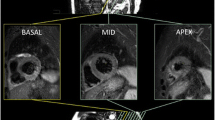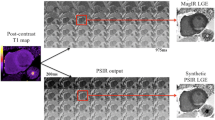Abstract
Area at risk (AAR) is an important parameter for the assessment of the salvage area after revascularization in acute myocardial infarction (AMI). By combining AAR assessment by T2-weighted imaging and scar quantification by late gadolinium enhancement imaging cardiovascular magnetic resonance (CMR) offers a promising alternative to the “classical” modality of Tc99m-sestamibi single photon emission tomography (SPECT). Current T2 weighted sequences for edema imaging in CMR are limited by low contrast to noise ratios and motion artifacts. During the last years novel CMR imaging techniques for quantification of acute myocardial injury, particularly the T1-mapping and T2-mapping, have attracted rising attention. But no direct comparison between the different sequences in the setting of AMI or a validation against SPECT has been reported so far. We analyzed 14 patients undergoing primary coronary revascularization in AMI in whom both a pre-intervention Tc99m-sestamibi-SPECT and CMR imaging at a median of 3.4 (interquartile range 3.3–3.6) days after the acute event were performed. Size of AAR was measured by three different non-contrast CMR techniques on corresponding short axis slices: T2-weighted, fat-suppressed turbospin echo sequence (TSE), T2-mapping from T2-prepared balanced steady state free precession sequences (T2-MAP) and T1-mapping from modified look locker inversion recovery (MOLLI) sequences. For each CMR sequence, the AAR was quantified by appropriate methods (absolute values for mapping sequences, comparison with remote myocardium for other sequences) and correlated with Tc99m-sestamibi-SPECT. All measurements were performed on a 1.5 Tesla scanner. The size of the AAR assessed by CMR was 28.7 ± 20.9 % of left ventricular myocardial volume (%LV) for TSE, 45.8 ± 16.6 %LV for T2-MAP, and 40.1 ± 14.4 %LV for MOLLI. AAR assessed by SPECT measured 41.6 ± 20.7 %LV. Correlation analysis revealed best correlation with SPECT for T2-MAP at a T2-threshold of 60 ms (ms) (slope = 0.99, Pearson’s r = 0.94), and for MOLLI at T1-threshold of 1,075 ms (slope 0.86, r = 0.91, Pearson’s r = 0.45). For the assessment of AAR in AMI, the novel T2-mapping technique correlates best with SPECT size, T1-mapping with MOLLI and standard T2-weighted imaging showed similar good correlations.


Similar content being viewed by others
References
Horstick G, Heimann A, Gotze O, Hafner G, Berg O, Bohmer P, Becker P, Darius H, Rupprecht HJ, Loos M, Bhakdi S, Meyer J, Kempski O (1997) Intracoronary application of C1 esterase inhibitor improves cardiac function and reduces myocardial necrosis in an experimental model of ischemia and reperfusion. Circulation 95(3):701–708
Okamura T, Miura T, Iwamoto H, Shirakawa K, Kawamura S, Ikeda Y, Iwatate M, Matsuzaki M (1999) Ischemic preconditioning attenuates apoptosis through protein kinase C in rat hearts. Am J Physiol 277(5 Pt 2):H1997–H2001
Saeed M, Bremerich J, Wendland MF, Wyttenbach R, Weinmann HJ, Higgins CB (1999) Reperfused myocardial infarction as seen with use of necrosis-specific versus standard extracellular MR contrast media in rats. Radiology 213(1):247–257. doi:10.1148/radiology.213.1.r99se30247
Wagner A, Mahrholdt H, Holly TA, Elliott MD, Regenfus M, Parker M, Klocke FJ, Bonow RO, Kim RJ, Judd RM (2003) Contrast-enhanced MRI and routine single photon emission computed tomography (SPECT) perfusion imaging for detection of subendocardial myocardial infarcts: an imaging study. The Lancet 361(9355):374–379. doi:10.1016/s0140-6736(03)12389-6
Hadamitzky M, Langhans B, Hausleiter J, Sonne C, Byrne RA, Mehilli J, Kastrati A, Schomig A, Martinoff S, Ibrahim T (2013) Prognostic value of late gadolinium enhancement in cardiovascular magnetic resonance imaging after acute ST-elevation myocardial infarction in comparison with single-photon emission tomography using Tc99m-sestamibi. Eur Heart J Cardiovasc Imaging. doi:10.1093/ehjci/jet176
Thiele H, Kappl MJ, Conradi S, Niebauer J, Hambrecht R, Schuler G (2006) Reproducibility of chronic and acute infarct size measurement by delayed enhancement-magnetic resonance imaging. J Am Coll Cardiol 47(8):1641–1645. doi:10.1016/j.jacc.2005.11.065
Friedrich MG, Abdel-Aty H, Taylor A, Schulz-Menger J, Messroghli D, Dietz R (2008) The salvaged area at risk in reperfused acute myocardial infarction as visualized by cardiovascular magnetic resonance. J Am Coll Cardiol 51(16):1581–1587. doi:10.1016/j.jacc.2008.01.019
Giri S, Chung YC, Merchant A, Mihai G, Rajagopalan S, Raman SV, Simonetti OP (2009) T2 quantification for improved detection of myocardial edema. J Cardiovasc Magn Reson Off J Soc Cardiovasc Magn Res 11:56. doi:10.1186/1532-429X-11-56
Verhaert D, Thavendiranathan P, Giri S, Mihai G, Rajagopalan S, Simonetti OP, Raman SV (2011) Direct T2 quantification of myocardial edema in acute ischemic injury. JACC Cardiovasc Imaging 4(3):269–278. doi:10.1016/j.jcmg.2010.09.023
Ferreira VM, Piechnik SK, Dall’armellina E, Karamitsos TD, Francis JM, Ntusi N, Holloway C, Choudhury RP, Kardos A, Robson MD, Friedrich MG, Neubauer S (2013) T1 mapping for the diagnosis of acute myocarditis using CMR: comparison to T2-weighted and late gadolinium enhanced imaging. JACC Cardiovasc Imaging 6(10):1048–1058. doi:10.1016/j.jcmg.2013.03.008
Messroghli DR, Walters K, Plein S, Sparrow P, Friedrich MG, Ridgway JP, Sivananthan MU (2007) Myocardial T1 mapping: application to patients with acute and chronic myocardial infarction. Magn Res Med Off J Soc Magn Res Med Soc Magn Res Med 58(1):34–40. doi:10.1002/mrm.21272
Ugander M, Bagi PS, Oki AJ, Chen B, Hsu LY, Aletras AH, Shah S, Greiser A, Kellman P, Arai AE (2012) Myocardial edema as detected by pre-contrast T1 and T2 CMR delineates area at risk associated with acute myocardial infarction. JACC Cardiovasc Imaging 5(6):596–603. doi:10.1016/j.jcmg.2012.01.016
Kellman P, Aletras AH, Mancini C, McVeigh ER, Arai AE (2007) T2-prepared SSFP improves diagnostic confidence in edema imaging in acute myocardial infarction compared to turbo spin echo. Magn Res Med Off J Soc Magn Res Med Soc Magn Res Med 57(5):891–897. doi:10.1002/mrm.21215
Naßenstein K NF, Schlosser T, Bruder O, Umutlu L, Lauenstein T, Maderwald S, Ladd ME. (2013) Cardiac MRI: T2-mapping versus T2-weighted dark-blood TSE imaging for myocardial edema visualization in acute myocardial infarction. Röfo 186(2):166–172
Hadamitzky M, Langhans B, Hausleiter J, Sonne C, Kastrati A, Martinoff S, Schomig A, Ibrahim T (2013) The assessment of area at risk and myocardial salvage after coronary revascularization in acute myocardial infarction: comparison between CMR and SPECT. JACC Cardiovasc Imaging 6(3):358–369. doi:10.1016/j.jcmg.2012.10.018
Gibbons RJ, Verani MS, Behrenbeck T, Pellikka PA, O’Connor MK, Mahmarian JJ, Chesebro JH, Wackers FJ (1989) Feasibility of tomographic 99 mTc-hexakis-2-methoxy-2-methylpropyl-isonitrile imaging for the assessment of myocardial area at risk and the effect of treatment in acute myocardial infarction. Circulation 80(5):1277–1286. doi:10.1161/01.cir.80.5.1277
O’Connor MK, Gibbons RJ, Juni JE, O’Keefe J, Ali A (1995) Quantitative myocardial SPECT for infarct sizing: feasibility of a multicenter trial evaluated using a cardiac phantom. J Nucl Med 36:1130
Moon JC, Messroghli DR, Kellman P, Piechnik SK, Robson MD, Ugander M, Gatehouse PD, Arai AE, Friedrich MG, Neubauer S, Schulz-Menger J, Schelbert EB (2013) Myocardial T1 mapping and extracellular volume quantification: a Society for Cardiovascular Magnetic Resonance (SCMR) and CMR Working Group of the European Society of Cardiology consensus statement. J Cardiovasc Magn Res Off J Soc Cardiovasc Magn Res 15:92. doi:10.1186/1532-429X-15-92
Papoulis A (1990) Probability and Statistics. Prentice-Hall International Editions, Upper Saddle River
R-Development-Core-Team (2010) R: a language and environment for statistical computing. http://www.R-project.org
Park CH, Choi EY, Kwon HM, Hong BK, Lee BK, Yoon YW, Min PK, Greiser A, Paek MY, Yu W, Sung YM, Hwang SH, Hong YJ, Kim TH (2013) Quantitative T2 mapping for detecting myocardial edema after reperfusion of myocardial infarction: validation and comparison with T2-weighted images. Int J Cardiovasc Imaging 29(Suppl 1):65–72. doi:10.1007/s10554-013-0256-0
Higgins CB, Herfkens R, Lipton MJ, Sievers R, Sheldon P, Kaufman L, Crooks LE (1983) Nuclear magnetic resonance imaging of acute myocardial infarction in dogs: alterations in magnetic relaxation times. Am J Cardiol 52(1):184–188
Ferreira VM, Piechnik SK, Dall’Armellina E, Karamitsos TD, Francis JM, Choudhury RP, Friedrich MG, Robson MD, Neubauer S (2012) Non-contrast T1-mapping detects acute myocardial edema with high diagnostic accuracy: a comparison to T2-weighted cardiovascular magnetic resonance. J Cardiovasc Magn Res Off J Soc Cardiovasc Magn Res 14:42. doi:10.1186/1532-429X-14-42
Piechnik SK, Ferreira VM, Dall’Armellina E, Cochlin LE, Greiser A, Neubauer S, Robson MD (2010) Shortened Modified Look-Locker Inversion recovery (ShMOLLI) for clinical myocardial T1-mapping at 1.5 and 3 T within a 9 heartbeat breathhold. J Cardiovasc Magn Res Off J Soc Cardiovasc Magn Res 12:69. doi:10.1186/1532-429X-12-69
Beller GA, Sinusas AJ (1990) Experimental studies of the physiologic properties of technetium-99m isonitriles. Am J Cardiol 66(13):5E–8E
Aletras AH, Tilak GS, Natanzon A, Hsu LY, Gonzalez FM, Hoyt RF Jr, Arai AE (2006) Retrospective determination of the area at risk for reperfused acute myocardial infarction with T2-weighted cardiac magnetic resonance imaging: histopathological and displacement encoding with stimulated echoes (DENSE) functional validations. Circulation 113(15):1865–1870. doi:10.1161/CIRCULATIONAHA.105.576025
Fishbein MC (1978) The histopathologic evolution of myocardial infarction. Chest J 73(6):843. doi:10.1378/chest.73.6.843
Abdel-Aty H, Cocker M, Meek C, Tyberg JV, Friedrich MG (2009) Edema as a very early marker for acute myocardial ischemia: a cardiovascular magnetic resonance study. J Am Coll Cardiol 53(14):1194–1201. doi:10.1016/j.jacc.2008.10.065
Conflict of interest
None.
Author information
Authors and Affiliations
Corresponding author
Additional information
Birgit Langhans and Jonathan Nadjiri contributed equally to this work.
Rights and permissions
About this article
Cite this article
Langhans, B., Nadjiri, J., Jähnichen, C. et al. Reproducibility of area at risk assessment in acute myocardial infarction by T1- and T2-mapping sequences in cardiac magnetic resonance imaging in comparison to Tc99m-sestamibi SPECT. Int J Cardiovasc Imaging 30, 1357–1363 (2014). https://doi.org/10.1007/s10554-014-0467-z
Received:
Accepted:
Published:
Issue Date:
DOI: https://doi.org/10.1007/s10554-014-0467-z




